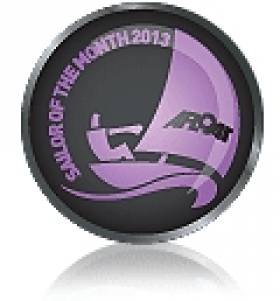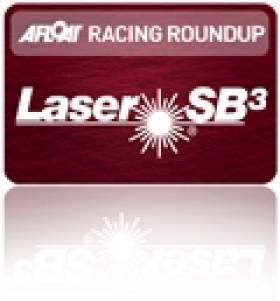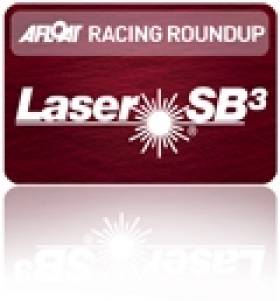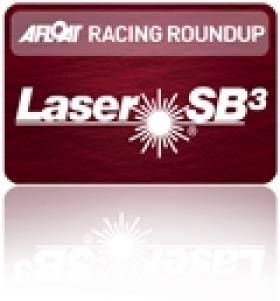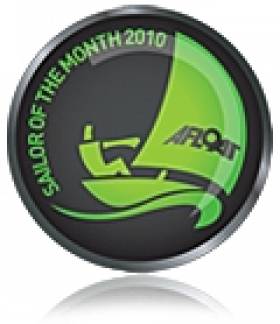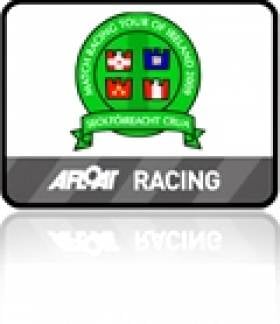Displaying items by tag: Ben Duncan
This weekend’s two-day All-Ireland Sailing Championship at the National Yacht Club in Dun Laoghaire, racing boats of the ISA J/80 SailFleet flotilla, is an easy target for facile criticism. Perhaps because it tries to do so much in the space of only two days racing, with just one type of boat and an entry of 15 class championship-winning helms, inevitably this means it will be seen by some as falling short of its high aspiration of providing a true Champion of Champions.
Yet it seldom fails to produce an absolute cracker of a final. Last year, current defending champion Anthony O’Leary of Cork, racing the J/80s in Howth and representing both ICRA Class 0 and the 1720 Sportsboats, snatched a last gasp win from 2013 title-holder Ben Duncan of the SB20s, thereby rounding out an utterly exceptional personal season for O’Leary which saw him go on to be very deservedly declared the Afloat.ie “Sailor of the Year” 2014.
So this year, with a host of younger challengers drawn from a remarkable variety of sailing backgrounds, the ever-youthful Anthony O’Leary might well see himself in the position of the Senior Stag defending his territory against half a dozen young bucks who will seem to attack him from several directions. And with winds forecast to increase in strength as the weekend progresses, differing talents and varying levels of athletic ability will hope to experience their preferred conditions at some stage, thereby getting that extra bit of confidence to bring success within their reach. It’s a fascinating scenario, and W M Nixon tries to set this unique event in perspective.
When the founding fathers of modern dinghy racing in Ireland set up the Irish Dinghy Racing Association (now the ISA) in 1946, they would have been reasonably confident that the immediate success of their new pillar event, the Helmsman’s Championship of Ireland, gave hope that a contest of this stature would still be healthily in being, and still run on a keenly-followed annual basis, nearly seventy years later.
They might even have been able to envisage that it would have been re-named the All-Ireland Championship, even if their original title of Helmsman’s Championship had a totally unique and clearly recognisable quality, for they’d have accepted its fairly harmless gender bias was going to create increasing friction with the Politically Correct brigade.
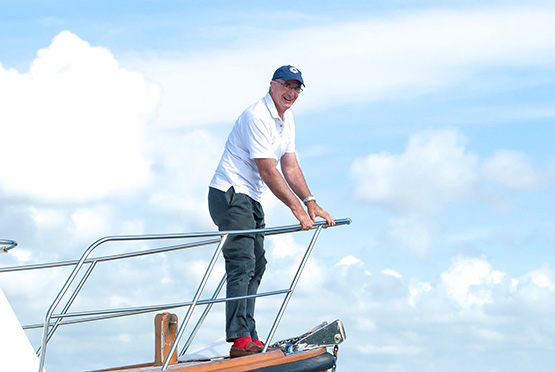 The Stag at Bay? Anthony O’leary sniffs the breeze last weekend, in charge of racing in the CH Marine Autumn league. This weekend he defends his All-Ireland title in Dun Laoghaire. Photo: Robert Bateman
The Stag at Bay? Anthony O’leary sniffs the breeze last weekend, in charge of racing in the CH Marine Autumn league. This weekend he defends his All-Ireland title in Dun Laoghaire. Photo: Robert Bateman
 Sailing should be fun, and run with courtesy – invitation to enjoyable racing, as displayed last weekend in Cork on Anthony O’Leary’s Committee Boat. Photo: Robert Bateman
Sailing should be fun, and run with courtesy – invitation to enjoyable racing, as displayed last weekend in Cork on Anthony O’Leary’s Committee Boat. Photo: Robert Bateman
But what those pioneering performance dinghy racers in 1946 can scarcely have imagined was that, 69 years later, no less than a quarter of the coveted places in the All-Ireland Championship lineup of 16 sailing stars would be going to helms who have qualified through winning their classes within the Annual National Championship of a thirteen-year-old all-Ireland body known as the Irish Cruiser-Racing Association.
And if you then further informed those great men and women of 1946 that those titles were all won in an absolute humdinger of a four-day big-fleet national championship staged in the thriving sailing centre and Irish gourmet capital of Kinsale, they’d have doubted your sanity. For in the late 1940s, Kinsale had slipped almost totally under the national sailing radar, while the town generally was showing such signs of terminal decline that there was little enough in the way of resources to put any food on any table, let alone think in terms of destination restaurants.
So in tracing the history of this uniquely Irish championship (for it long pre-dates the Endeavour Trophy in England), we have a convenient structure to hold together a manageable narrative of the story of Irish sailboat racing since the end of World War II. Add in the listings of the Irish Cruising Club trophies since the first one was instituted in 1931, then cross-reference this info with such records as the winners of the Round Ireland race and the Dun Laoghaire to Dingle Race, beef it all up with the winners of the national championship of the largest dinghy and inshore keelboat classes, and a comprehensible narrative of our national sailing history emerges.
 The veteran X332 Equinox (Ross McDonald) continues to be a force in Irish cruiser-racing, and by winning her class in the ICRA Nationals in Kinsale at the end of June, Equinox is represented in the All Irelands this weekend by helmsman Simon Rattigan. Photo: W M Nixon
The veteran X332 Equinox (Ross McDonald) continues to be a force in Irish cruiser-racing, and by winning her class in the ICRA Nationals in Kinsale at the end of June, Equinox is represented in the All Irelands this weekend by helmsman Simon Rattigan. Photo: W M Nixon
It’s far from perfect, but it’s a defining picture nevertheless, even if it lacks the inside story of the clubs. Be that as it may, in looking at it properly, we get a greater realization that the All-Ireland Helmsman’s Championship (or whatever you’re having yourself) is something very important, something to be cherished and nurtured from year to year.
Of course I’m not suggesting that we should all be out in Dublin Bay today and tomorrow on spectator boats, avidly watching every twist and turn as eight identical boats race their hearts out with a variety of helms calling the shots. Unless you’re in a particular helmsperson’s fan club, it’s really rather boring to watch from end to end, or at least until the conclusion of each stage and then the final races.
This is very much a sport for the “edited highlights”. The reality is that no matter how they try to jazz it up, sailing is primarily of interest only to those actively taking part, or directly engaged in staging each event. When great efforts are made to make it exciting for casual spectators, it costs several mints and results in rich people and highly-resourced teams engaged in costly and often unseemly battles to which genuine sporting sailors cannot really relate at all.
But with its exclusion of Olympic and some High Performance squad members, the All-Ireland in its current form is the quintessence of Irish local and national sailing. It’s almost compulsive for its participants, it provides an extra interest for their supportive clubmates, and in its pleasantly low key way it’s a genuine expression of real Irish sailing, the sailing of L’Irlande profonde.
So of course we agree that it might be more interesting for the bright young people if it was raced in something more trendy like the RS400s if they could find sufficient owners to risk their boats in this particular bear pit. And yes indeed, the ISA Discussion Paper and Helmsmans Guidelines of 2012 did indeed hope that within three years, the All Ireland would be staged in dinghies.
But we have to live in the real world. Sailing really is a sport for life, and some of our best sailors are truly seniors who would be disadvantaged if it was raced in a boat making too many demands on sheer athleticism, for which the unattainable Olympic Finn would be the only true answer.
But in any case, if you watch J/80s racing in a breeze, there’s no doubting the advantage a bit of athletic ability confers, yet the cunning seniors can overcome their lack of suppleness and agility with sheer sailing genius.
 While they may be keelboats, in a breeze the J/80s will sail better with some athleticism, as displayed here by Ben Duncan (second left) as he sweeps toward the finish and victory in the 2013 All Irelands at Howth. Photo: Aidan Tarbett
While they may be keelboats, in a breeze the J/80s will sail better with some athleticism, as displayed here by Ben Duncan (second left) as he sweeps toward the finish and victory in the 2013 All Irelands at Howth. Photo: Aidan Tarbett
 Yet a spot of sailing genius can offset the adverse effects of advancing years – Anthony O’Leary (right) with Dylan Gannon (left) and Dan O’Grady after snatching victory at the last minute in 2014. Photo: Jonathan Wormald.
Yet a spot of sailing genius can offset the adverse effects of advancing years – Anthony O’Leary (right) with Dylan Gannon (left) and Dan O’Grady after snatching victory at the last minute in 2014. Photo: Jonathan Wormald.
But another reality we have to accept is that Ireland is only just crawling out of the Great Recession. And in that recession, it was the enduring competitiveness of ageing cruiser-racers and the sporting attitude of their owners which kept the national sailing show on the road. Your dyed-in-the-wool dinghy sailor may sneer at the constrictions of seaborn truck-racing. But young sailors who were realists very quickly grasped that if they wanted to get regular sailing with good competition as the Irish economy went into free fall, then they had to hone their skills in making boats with lids, crewed by tough old birds most emphatically not in the first flush of youth, sail very well indeed.
Thus in providing a way for impecunious young people to keep sailing through the recession, ICRA performs a great service for Irish sailing. And the productive interaction between young and old in the ICRA fleets, further enlivened by their different sailing backgrounds, has resulted in a vibrant new type of sailing community where it is regarded as healthily normal to be able to move between dinghies and keelboats and back again.
The final lineup of entries is a remarkable overview of the current Irish racing scene, and if you wonder why the winner of the GP14 British Opens 2015, Shane McCarthy of Greystones, is not representing the GP 14s, the word is he’s unavailable, so his place is taken by Niall Henry of Sligo.
2014 Champion Anthony O'Leary, RCYC
RS400 Alex Barry, Monkstown Bay SC
GP14 Niall Henry ,Sligo Yacht Club
Shannon OD Frank Browne, Lough Ree YC
Flying Fifteen David Gorman, National YC
Squib Fergus O'Kelly, Howth YC
ICRA 1 Roy Darrer, Waterford Sailing Club
Mermaid Patrick, Dillon Rush SC
Laser Std Ronan Cull, Howth YC
SB20 Michael O'Connor, Royal St.George YC
IDRA14 Alan Henry, Sutton DC
RS200 Frank O'Rourke, Greystones SC
ICRA 2 Simon Rattigan, Howth YC
ICRA 4 Cillian Dickson, Howth YC
Ruffian Chris Helme, Royal St.George YC
As a three-person boat with a semi-sportsboat performance, the J/80 is a reasonable compromise between dinghies and keelboats, and the class has the reputation of being fun to sail, which is exactly what’s needed here.
The Sailing Olympics and the ISAF Worlds may be terribly important events for sailing in the international context, but nobody would claim they’re fun events. Equally, though, you wouldn’t dream of suggesting the All-Ireland is no more than a fun event. But it strikes that neat balance between tough sport and sailing enjoyment to make it quite a good expression of the true Irish amateur sailing scene.
Inevitably from time to time it produces a champion whose sailing abilities are so exceptional that it would amount to a betrayal of their personal potential for them not to go professional in some way or other. But fortunately sailing is such a diverse world that two of the outstanding winners of the Helmsman’s Championships of Ireland have managed to make their fulfilled careers as top level professional sailors without losing that magic sense of fun and enjoyment, even though in both cases it has involved leaving Ireland.
Their wins were gained in the classic early Irish Yachting Association scenario of a one design class which functioned on a local basis being able to provide enough reasonably-matched boats to be used for the Helmsman’s, and the three I best remember were when Gordon Maguire won in 1982 on Lough Derg racing Shannon One Designs, then in the 1970s Harold Cudmore won on Lough Neagh racing Flying Fifteens, and in 1970 itself, a very young Robert Dix was winner racing National 18s at Crosshaven.
Gordon Maguire was the classic case of a talented sailor having to get out of Ireland to fulfill himself. His win in 1982 in breezy conditions at Dromineer in Shannon One Designs, with Dave Cummins of Sutton on the mainsheet, was sport at its best, though I doubt that some of the old SODs were ever the better again after the hard driving they received.
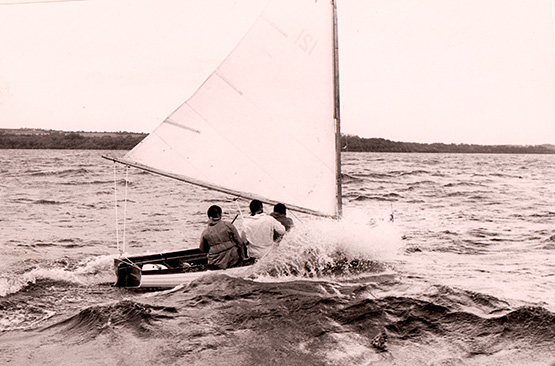 Driving force. Gordon Maguire going indecently fast for a Shannon One Design, on his way to winning the Helmsmans Championship of Ireland at Dromineer in 1982. Photo: W M Nixon
Driving force. Gordon Maguire going indecently fast for a Shannon One Design, on his way to winning the Helmsmans Championship of Ireland at Dromineer in 1982. Photo: W M Nixon
Then Gordon spread his wings, and won the Irish Windsurfer Nationals in 1984 - a great year for the Maguires, as his father Neville (himself a winner of the Helmsmans Championship five times) won the ISORA Championship with his Club Shamrock Demelza the same weekend.
But Gordon needed a larger canvas to demonstrate his talents, and in 1991 he was a member of the Irish Southern Cross team in Australia, a series which culminated in the Sydney-Hobart Race. The boat which Maguire was sailing was knocked out in a collision with another boat (it was the other boat’s fault), but Maguire found a new berth as lead helm on the boat Harold Cudmore was skippering for the Hobart Race, and they won that overall.
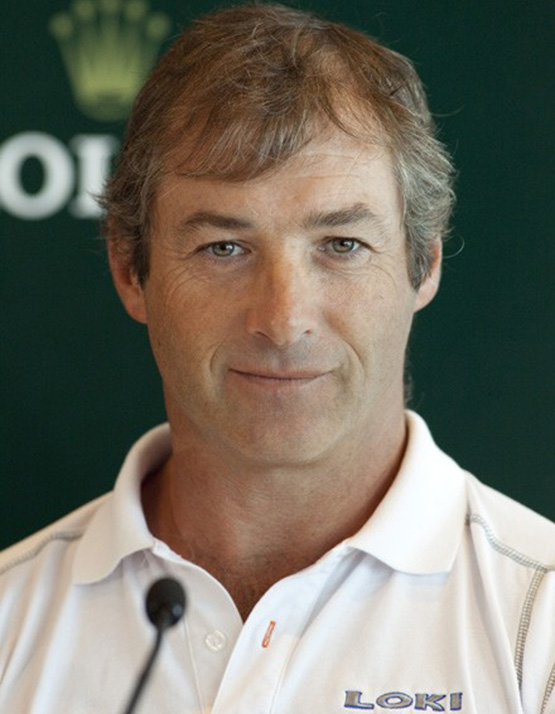 A man fulfilled, Gordon Maguire at the beginning of his hugely successful linkup with Stephen Ainsworth’s RP 63 Loki
A man fulfilled, Gordon Maguire at the beginning of his hugely successful linkup with Stephen Ainsworth’s RP 63 Loki
And Gordon Magure realized that for his talents, Australia was the place to be. More than twenty years later, he was to get his second Hobart Race overall win in command of Stephen Ainsworth’s RP 63 Loki, and here indeed was a man fulfilled, revelling in a chosen career which would have been unimaginable in Ireland.
Harold Cudmore had gone professional as best he could in 1974, but it was often a lonely and frustrating road in Europe. However, his win of the Half Ton Worlds in Trieste in the Ron Holland-designed, Killian Bushe-built Silver Shamrock in 1976 put his name up in lights, and he has been there ever since, renowned for his ability to make any boat perform to her best. It has been said of him when racing the 19 Metre Mariquita in the lightest conditions, that you could feel him getting an extra ounce of speed out of this big and demanding gaff-rigged classic seemingly by sheer silent will power.
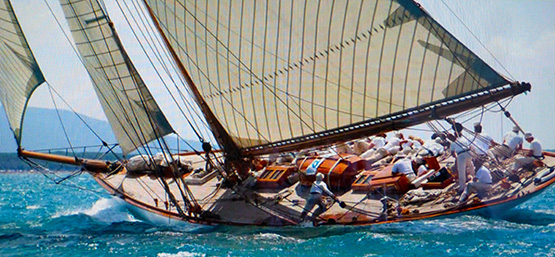
The restored 19 Metre Mariquita is a demanding beast to sail in any conditions…

...but in light airs, Harold Cudmore (standing centre) seems to be able to get her to outsail larger craft by sheer will-power.
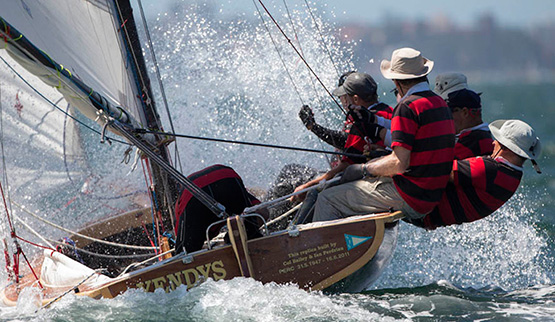 A different scene altogether, but still great sport – Harold Cudmore racing the classic Sydney Harbour 18-footer Yendys
A different scene altogether, but still great sport – Harold Cudmore racing the classic Sydney Harbour 18-footer Yendys
But as for Robert Dix’s fabulous win in 1970, while he went on to represent Ireland in the 1976 Olympics in Canada, he has remained a top amateur sailor who is also resolutely grounded in Irish business life (albeit at a rather stratospheric level). But then it could be argued that nothing could ever be better than winning the Helmsmans Championship of Ireland against the cream of Irish sailng when you’re just 17 years old, and doing it all at the mother club, the Royal Cork, as it celebrated its Quarter Millenium.
It was exactly 44 years ago, the weekend of October 3rd-4th 1970, and for Robert Dix it was a family thing, as his brother-in-law Richard Burrows was Number 2 in the three-man setup. They were on a roll, and how. The manner in which things were going their way was shown in an early race when they were in a tacking duel with Harold Cudmore. Coming to the weather mark, Cudmore crossed them on port, but the Dix team had read it to such perfection that by the time he had tacked, they’d shot through the gap with inches to spare and Cudmore couldn’t catch them thereafter.

Decisive moment in the 1970 Helmsman’s Championship. At the weather mark, Harold Cudmore on port is just able to cross Robert Dix on starboard………Photo W M Nixon
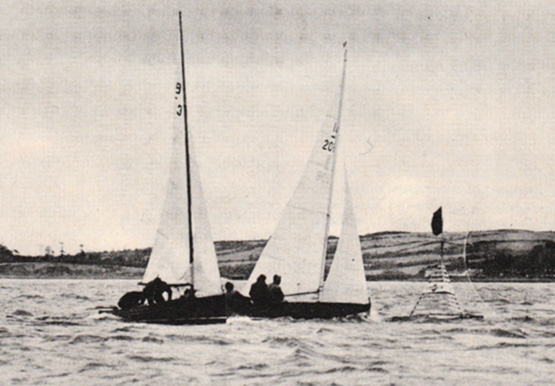 ……but Dix is able to shoot through the gap as Cudmore tacks…..Photo: W M Nixon
……but Dix is able to shoot through the gap as Cudmore tacks…..Photo: W M Nixon
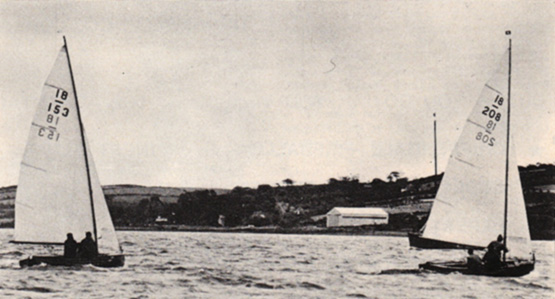 …..and is on his way to a win which will count well towards his overall victory over Cudmore by 0.4 points. Photo: W M Nixon
…..and is on his way to a win which will count well towards his overall victory over Cudmore by 0.4 points. Photo: W M Nixon
Admittedly both Harold Cudmore and the equally-renowned Somers Payne had gear problems, but even allowing for that, the 17-year-old Robert Dix from Malahide was the star of the show, and the final points of Robert Dix 9.5 and Harold Cudmore 9.9 for the 1970 Helmsman’s Championship of Ireland says it all, and it says it as clearly now as it did then.
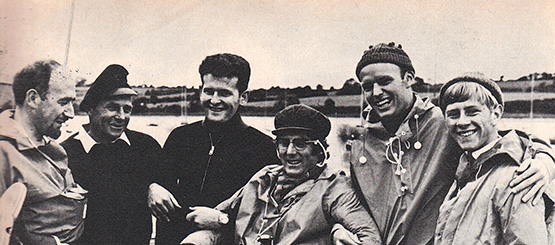
The six finalists in the 1970 Helmsman’s Championship were (left to right) Michael O’Rahilly Dun Laoghaire), Somers Payne (Cork), Harold Cudmore (Cork), Owen Delany (Dun Laoghaire), Maurice Butler (Ballyholme, champion 1969) and Robert Dix (Malahide), at 17 the youngest title holder ever. Photo: W M Nixon
Ben Duncan, Sailor of the Month for December
#sailor of the month – With a cut-off date at midnight on Christmas Eve, the lineup for Afloat.ie's "Sailor of the Month" title for December provides only three weeks of peformance time, but it allows the adjudicators to spread their net across the entire year's sailing.
And throughout 2013, one sailor was in close contention for the "Sailor of the Month" award more times than anyone else, yet always missed the top title by a hairsbreadth. But when his year-long performance is considered in its entirety, Ireland's resident Kiwi skipper Ben Duncan is in a league of his own. And as revealed in the Afloat Annual 2014, Ben Duncan became Sailor of the Month for December as the sleigh bells started to jingle.
Duncan is best known for his scientific and extremely thorough approach to campaigning his SB20 at home and abroad. He has raised the sailing of these very special boats to a new level. And in October, after a season of success at home and abroad, he was on top of his form to win the concluding championship on Lough Derg.
But the Duncan success path in 2013 didn't end there. The end of October brought a highly specialised challenge to all the top helms and Race Officer Neil Murphy. The All Ireland Championship at Howth in the SailFleet J/80s, scheduled as a two day event, had to be put through in just one day's very crisply organised racing as one big storm cleared to the eastward, and another roared in from the west.
To add to the unnerving situation, a weather front with gale force gusts came streaking through at mid-event, requiring everyone to return to the harbour. Yet despite the interruptions, the programme was completed with excellent racing, with sunshine for a bonus. And despite sailing in a boat other than his beloved SB20, Ben Duncan put in the performance of a lifetime for a runaway win to round out a great year.
Lough Derg Success for Duncan at SB20 Freshwater Regatta
#sb20 – 'Get Out and Sail' was the war cry from the SB20 fleet and 16 boat were expected at Lough Derg Freshwater Regatta at the weekend writes Justin Burke. The war cry was answered with 24 SB20s racing. Maybe this is the bounce for the recent successful SB20 Open Day, we will just have to wait and see? There is a great buzz in the class, pity the season has come to an end.
The SB 20 had 4 excellent racing W/L races on Saturday and one on Sunday. The Saturday racing was typical lake racing shifty with constantly changing pressure . As usual Ben Duncan was best able to adapt with 3 firsts and a 5th and this was enough for him to win the regatta.
The reunited Dowling Brothers Jerry and Jimmy ably chauffeured by Stefan Hyde stayed in the top 6 in each race to secure 2nd. Peter Kennedy proved that consistency is a winning formula , well almost , and finished 3rd. The silver fleet bubbled to the top with Kate Nagle in 6th edging out Mary Creedon in 7th, both creditable results, leaving some noted sailors with some excuses. As ever Lough Derg YC put in a huge effort to make everyone welcome, and with warm weather and a good breeze the regatta was a resounding success.
Royal Cork Yacht Club's Mel Collins is top Irish boat in 24th place after the first days racing of the 2011 SB3 World Championships in Torbay. Scroll down for pics and Video.
Collins Finishes 11th Overall. Results here
Collins scored 18, 8, 21 to be in the top quarter of the fleet, two points ahead of Irish East Coast Champion Ben Duncan who is sailing for his native New Zealand. The next Irish boat is Howth's Paul McMahon in 46th with Irish placings also in 47th, 48th and 49th. Full Results below.
The 103 boat fleet of Laser SB3's left Torquay Harbour this morning for the first three races. Split into 2 fleets, Orange and Yellow, the fleet lined up for the first scheduled race at 11.00 am. The Race Committee, on both courses, managed to get both fleets underway exactly to schedule. Impressive.
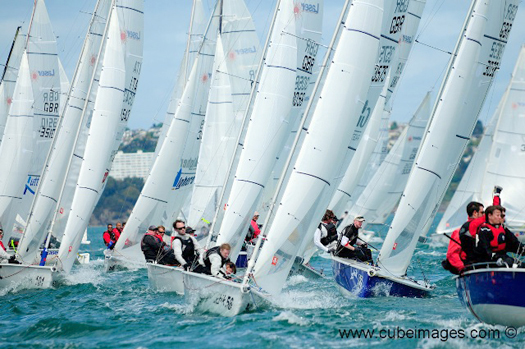
On the Yellow course, Robert Greenhalgh (GBR) showed his talent early on. Notching up a 1, 2, 1 on day one of a World Championships is a score card anyone would be proud of. Peter Saxton (GBR) won the first race on the Orange course and followed up with a 5, 2 placing him second overall overnight on day 1.
Nathan Outteridge (AUS) collected bowman Tom Slingsby (AUS) from the airport at 1am this morning, but lack of sleep and time on the water as a crew did little to dampen his crew's performance. "This is my first day on bow ever! There's a bit on when you get to the bottom mark" smiled Slingsby after completing the first race of the Championships, and their first race ever as a team with fellow Aussie Ian Brown.
The Orange course suffered 2 general recalls as the Race Committee tried to get the second race of the day away. Not deterred by the delay, Glenn Bourke (AUS) dominated the race, extending his lead on each leg. Chatting to Glenn last night he claimed to be "rusty", but today he posted 5, 1, 11 on the score sheet. "More time in the boat will help us iron out some of our creases, but to take a win on the first day of an event like this always makes you feel good!"
2010 Laser SB3 World Champion Jerry Hill (GBR) had a difficult day to start the event. Sailing on the Orange course the 3 Sad Old Blokes struggled in the first race, finishing in 25th position. After starting deep in the second race, they picked their way back to a respectable 9th and despite damage, finished 6th in the third race of the day. "It was hard today, really hard," explained Hill before disappearing to repair his boat.
Joe Llewellyn (GBR) grew up sailing in Tor Bay, and finished the first day of the Zhik SB3 World Championships with a win on the Orange course. Chatting to Joe in the bar of the Royal Torbay Yacht Club after racing he explained, "It was hard conditions today and we had a bad second race. We had some luck in the third race, we benefitted from some of the shifts and we won!" Joe recently became a father again, this time to twins, "I'm looking forward to another sleepless night tonight, and another day on the water tomorrow!"
Three further races are scheduled for Tuesday 17th May. The fleet is slit again, simply by their odd or even overall position at the end of the first day of racing, for the final day of qualifying races.
| Series Place | Sail No | Bow No | Boat | Helm | Series Points | Race 1A | Race 1B | Race 2A | Race 2B | Race 3A | Race 3B |
|---|---|---|---|---|---|---|---|---|---|---|---|
| 1 | GBR3489 | 19 | Red | Robert Greenhalgh | 4 | 1 | 2 | 1 | |||
| 2 | GBR3065 | 65 | Rola-Trac | Peter Saxton | 8 | 1 | 5 | 2 | |||
| 3 | GBR3042 | 54 | Gill Racing Team | Craig Burton | 9 | 4 | 3 | 2 | |||
| 4 | AUS3063 | 32 | One Design Sailing | Nathan Outteridge | 13 | 6 | 4 | 3 | |||
| 5 | GBR3053 | 111 | Geoff Carveth | 15 | 4 | 2 | 9 | ||||
| 6 | GBR3032 | 92 | David Cummins | 16 | 3 | 8 | 5 | ||||
| 7 | AUS3108 | 70 | Club Marine | Glenn Bourke | 17 | 5 | 1 | 11 | |||
| 8 | RSA3469 | 49 | Asenaithi Jim | 17 | 3 | 4 | 10 | ||||
| 9 | GBR3082 | 68 | Joe Llewellyn | 20 | 6 | 13 | 1 | ||||
| 10 | GBR3058 | 15 | John Pollard | 22 | 2 | 6 | 14 | ||||
| 11 | NED3441 | 17 | Rivium | Paul Gast | 22 | 9 | 5 | 8 | |||
| 12 | GBR3475 | 57 | Perky III | Jez Entwistle | 23 | 12 | 6 | 5 | |||
| 13 | ITA3073 | 39 | Stenghele | Roberto Caresani | 24 | 2 | 3 | 19 | |||
| 14 | GER3561 | 86 | Razzmatazz | Sebastian Dohrendorf | 26 | 12 | 7 | 7 | |||
| 15 | GBR3462 | 58 | Underground Toys | Andrew Oddie | 30 | 19 | 1 | 10 | |||
| 16 | GBR3134 | 84 | Marilyn | Dom Ford | 32 | 5 | 18 | 9 | |||
| 17 | GBR3198 | 80 | Magic Marine | Hugh Styles | 34 | 15 | 12 | 7 | |||
| 18 | GBR3047 | 95 | Parkway Pirates | Rob Gullan | 35 | 9 | 14 | 12 | |||
| 19 | GBR3546 | 98 | Orthteam | Richard Catchpole | 38 | 7 | 18 | 13 | |||
| 20 | GBR3149 | 16 | Poor Buoy | Mark Gillett | 39 | 17 | 16 | 6 | |||
| 21 | GBR3465 | 26 | 3 Sad Old Blokes | Jerry Hill | 40 | 25 | 9 | 6 | |||
| 22 | GBR3336 | 8 | Uber 3 | Adrian Peach | 41 | 8 | 15 | 18 | |||
| 23 | GBR3027 | 63 | Darling Associates | Chris Darling | 44 | 10 | 11 | 23 | |||
| 24 | IRL3324 | 22 | Sibelus | Mel Collins | 46 | 17 | 8 | 21 | |||
| 25 | NZL3287 | 36 | Sailing West - Sharkbait | Ben Duncan | 48 | 16 | 28 | 4 | |||
| 26 | GBR3029 | 44 | 3-Some | Niall Peelo | 49 | 11 | 16 | 22 | |||
| 27 | GBR3517 | 75 | Doolalli | Colin Simonds | 49 | 18 | 19 | 12 | |||
| 28 | GBR3276 | 89 | Trouble & Strife | Ian Armstrong | 50 | 11 | 20 | 19 | |||
| 29 | GBR3464 | 5 | Eric | Martin Wedge | 50 | 15 | 13 | 22 | |||
| 30 | GBR3556 | 69 | Herbie | Phil Tilley | 51 | 7 | 29 | 15 | |||
| 31 | GER3402 | 21 | Norah | Daniel Spaenle | 51 | 14 | 17 | 20 | |||
| 32 | ITA3543 | 101 | Bravi Thytronic | Giovanni Meloni | 52 | 23 | 12 | 17 | |||
| 33 | GBR3305 | 55 | Rigging Gurus | Mark Richards | 54 | 26 | 25 | 3 | |||
| 34 | GBR3575 | 56 | Sailboat Deliveries | Sarah Allan | 54 | 29 | 9 | 16 | |||
| 35 | UKR3443 | 78 | Transbunker | Polovy Valeriy | 54 | 27 | 14 | 13 | |||
| 36 | GBR3510 | 52 | Hutton's | Richard Wharram | 56 | 21 | 10 | 25 | |||
| 37 | GBR3041 | 67 | Robina | Dan Goodman | 58 | 16 | 24 | 18 | |||
| 38 | AUS3607 | 104 | Wysiwyg VI | Stephen Fries | 63 | 22 | 10 | 31 | |||
| 39 | RUS373 | 106 | Alissa | Vladislav Ivanovski | 63 | 29 | 20 | 14 | |||
| 40 | GBR3079 | 116 | Excuse Me Gents | Ann Jackson | 64 | 19 | 37 | 8 | |||
| 41 | RUS3554 | 109 | Team Russia | Rodion Luka | 65 | 8 | 53 | 4 | |||
| 42 | GBR3183 | 30 | Respect | John Danby | 67 | 33 | 11 | 23 | |||
| 43 | GBR3014 | 61 | Sponge Bob | Steve McLean | 69 | 13 | 22 | 34 | |||
| 44 | FRA3078 | 115 | Tad Minus | Vincent Biarnes | 69 | 28 | 17 | 24 | |||
| 45 | BEL3472 | 35 | Los Zaparteros | Alex Schoenmakers | 71 | 14 | 21 | 36 | |||
| 46 | IRL3226 | 112 | Quantitative Easing | Paul McMahon | 76 | 35 | 30 | 11 | |||
| 47 | IRL3312 | 91 | Bomchickawahwah | John O'Driscoll | 77 | 32 | 30 | 15 | |||
| 48 | IRL3338 | 59 | Milvus Milvus | Robert Howe | 77 | 30 | 21 | 26 | |||
| 49 | IRL3298 | 64 | Toucan 3 | Ross Vaughan | 79 | 43 | 19 | 17 | |||
| 50 | GBR3084 | 1 | Eau No! | Mark Sotkes | 80 | 20 | 34 | 26 | |||
| 51 | ITA3596 | 99 | Briefing | Luca Bacci | 83 | 39 | 24 | 20 | |||
| 52 | GBR3468 | 60 | Fully Badgered | Paul Lovejoy | 84 | 10 | 32 | 42 | |||
| 53 | GBR3126 | 102 | Geronimo | Simon Hume | 86 | 28 | 23 | 35 | |||
| 54 | GBR3106 | 37 | Tom Clay | 87 | 21 | 29 | 37 | ||||
| 55 | ITA3606 | 114 | Lunatico XS | Aurelio Bini | 88 | 20 | 15 | 53 | |||
| 56 | GBR3292 | 93 | Chill Pill | Tich Summers | 89 | 41 | 7 | 41 | |||
| 57 | GBR3060 | 73 | Finitor 7 | Stewart Reed | 89 | 35 | 26 | 28 | |||
| 58 | NED3511 | 29 | Marco van Driel | 90 | 32 | 26 | 32 | ||||
| 59 | GBR3362 | 47 | Polar Bear | Tim Newton | 92 | 34 | 42 | 16 | |||
| 60 | GBR3379 | 27 | Joyride | Nick Andrews | 92 | 18 | 23 | 51 | |||
| 61 | IRL3307 | 31 | Bad/Kilcullen | Stephan Hyde | 92 | 36 | 22 | 34 | |||
| 62 | GBR3545 | 71 | Savage Sailing Team | Chris Savage | 92 | 31 | 32 | 29 | |||
| 63 | FRA3423 | 76 | Morpheus | Edward Russo | 93 | 37 | 31 | 25 | |||
| 64 | GBR3038 | 119 | TeamB4Ego,com2 | Will Brooks | 95 | 13 | 40 | 42 | |||
| 65 | GBR3021 | 51 | Here Comes Bod | Charlie Whelan | 95 | 44 | 27 | 24 | |||
| 66 | GBR3074 | 3 | Tonic | Douglas Paton | 95 | 27 | 33 | 35 | |||
| 67 | FRA3609 | 2 | Marcon Yachting | Louis Marcon | 97 | 34 | 25 | 38 | |||
| 68 | GBR3516 | 14 | TeamB4Ego.com | Geoff Gritton | 97 | 25 | 36 | 36 | |||
| 69 | GBR3515 | 108 | The Young Pretender | Callum Calder | 98 | 24 | 53 | 21 | |||
| 70 | GBR3215 | 79 | Sail Navy | Darren Roach | 98 | 24 | 27 | 47 | |||
| 71 | GBR3267 | 77 | Neilson Heart of Gold | Tom Hayhoe | 99 | 22 | 47 | 30 | |||
| 72 | GER3600 | 13 | Isabella III | Reinhard Schroeder | 99 | 23 | 46 | 30 | |||
| 73 | IRL3484 | 33 | Seriously Bonkers x 3 | Martin Cuppage | 103 | 26 | 44 | 33 | |||
| 74 | GBR3319 | 12 | Devils Advocate | Tony Jaffa | 103 | 43 | 33 | 27 | |||
| 75 | GBR3081 | 9 | Prostate Cancer Charity | Ross Lang | 107 | 36 | 28 | 43 | |||
| 76 | GBR3335 | 24 | Royal Signals | Stu Southan | 108 | 31 | 38 | 39 | |||
| 77 | POR3103 | 48 | Viero | Piedade Colaco | 110 | 38 | 45 | 27 | |||
| 78 | GBR3069 | 66 | Not just a number | Paul Hine | 110 | 42 | 37 | 31 | |||
| 79 | GBR3104 | 74 | Retail Therapy | Charles Sheppard | 111 | 40 | 38 | 33 | |||
| 80 | GBR3056 | 100 | Woohoo | Tom Davidson | 114 | 45 | 41 | 28 | |||
| 81 | GBR3088 | 6 | Healthy1.co.uk | Ray Davies | 114 | 40 | 34 | 40 | |||
| 82 | ITA3598 | 96 | Alghero Giorico Hotels | Alessandro Balzani | 115 | 38 | 35 | 42 | |||
| 83 | GBR3096 | 72 | Red Kite | Roger Harford | 116 | 30 | 47 | 39 | |||
| 84 | AUS3224 | 28 | Jester 3 | Dave Bull | 118 | 50 | 31 | 37 | |||
| 85 | GBR3048 | 23 | Control-Alt-Delete | Ann Ashworth | 120 | 33 | 44 | 43 | |||
| 86 | GBR3094 | 20 | Xceptable | Ian Lievesley | 123 | 52 | 39 | 32 | |||
| 87 | UKR3522 | 41 | Stemcor | Valentin Klymentyev | 125 | 46 | 35 | 44 | |||
| 88 | ITA3437 | 53 | Lupi D'irlanda | Marco Sorgassi | 125 | 39 | 42 | 44 | |||
| 89 | IRL3062 | 40 | Ronan Downing | 131 | 37 | 49 | 45 | ||||
| 90 | GBR3531 | 87 | Carnage | Nick Over | 132 | 44 | 50 | 38 | |||
| 91 | GBR3077 | 88 | Skallywag | Rob Day | 132 | 46 | 40 | 46 | |||
| 92 | GBR3519 | 107 | May contain nuts | John Greenaway | 133 | 41 | 43 | 49 | |||
| 93 | NED3470 | 82 | Cube | Martijn Buitenhuis | 134 | 42 | 43 | 49 | |||
| 94 | GBR3309 | 43 | Narwhal | David Bates | 135 | 51 | 36 | 48 | |||
| 95 | IRL3297 | 90 | Sunday Brunch | Richard Tate | 136 | 49 | 46 | 41 | |||
| 96 | GBR3473 | 85 | Sceptre | Nathan Bailey | 138 | 50 | 48 | 40 | |||
| 97 | GBR3366 | 11 | Hooligan | Guy Broom | 138 | 47 | 41 | 50 | |||
| 98 | IRL3033 | 34 | Blue Bird | Cathy MacAleavey | 139 | 47 | 39 | 53 | |||
| 99 | GRE3251 | 105 | SailingHolidays.com | Ruairi Bradley | 140 | 45 | 49 | 46 | |||
| 100 | GBR3540 | 46 | Water Music viii | Jonny Foot | 143 | 51 | 45 | 47 | |||
| 101 | GBR3368 | 45 | Kapow | Nick Barnett | 144 | 48 | 48 | 48 | |||
| 102 | GBR3123 | 4 | Mini Mayhem | Paul Craft | 146 | 48 | 53 | 45 | |||
| 103 | IRL3315 | 42 | Sirius Black | Ken Hudson | 152 | 49 | 51 | 52 |
Annalise Murphy Lines up for SB3 Eastern Championships in Howth
Unless last year's champion Gareth Flanigan and his crew can beg, steal or borrow a boat, they won't be able to defend their title and a new winner will be crowned on May 1st. The recent Spring Warmer Series saw some boats post inconsistent results while two teams in particular stepped up from last year to place themselves in the running.
Eoin Quinlan's decision to team up with Mike Evans and Peter Frane with 'Shockwave' looked like a smart one, with consistent results putting them on top of that series, and giving them the confidence to make the top 3 or 4 places at the Easterns.
John O'Driscoll of the Royal St.George is another skipper in flying form and will be hopeful of a good overall result next weekend. HYC's own 'Sharkbait' (Ben Duncan/Brian Moran/Rick Morris) can never be under-estimated and will be tipped to be among the prime contenders.
A feature of the event is the entry of several women helms, the most notable being Olympic hopeful Annalise Murphy of the National YC with her mother (and former Olympian) Cathy MacAleavey crewing.
Ten Irish Sign up for Torquay SB3 World Champs
But top ranked Irish performer Ben Duncan, who races from Howth Yacht Club is entered under his native New Zealand flag.
Seriously Bonkers (Martin Cuppage), Bad Kilcullen (Jerry Dowling) and Cathy MacAleavey's Bluebird are among Dun Laoghaire boats to enter so far. The full entry list is here.
The event will be hosted by the Royal Torbay Yacht Club, UK from 16 – 20 May 2011.
Representatives from fourteen nations will compete in the World Championships. The host nation field an entry of over seventy boats. Entries come from as far afield as Australia and South Africa. Ireland, France, The Netherlands, Portugal, Greece, Switzerland, Belgium, Germany, Ukraine and Russia will all be represented in Torquay in May.
The three Laser SB3 World Champions, Geoff Carveth (2008 Champion, Dun Laoghaire), Craig Burlton (2009 Champion, Cascais) and Jerry Hill (2010 Champion, Torbole) will all compete for the 2011 Championship title.
Carveth, Burlton and Hill are all British and so far the Laser SB3 World Championship has not been won by another nation. Will 2011 see the trophy slip from the Brits grip?
Australian sailing man of the moment, Nathan Outteridge, will compete with Laser SB3 Class President, Dave Cheyne in Torquay in May. Outteridge is twice 49er World Champion, current Moth World Champion and recent winner of the Audi King of Docklands and Audi Victoria Week in the Laser SB3. Fellow Australian Glenn Bourke returns to the class for the Championship.
South Africa’s Roger Hudson will compete in his fourth Laser SB3 World Championship and will no doubt be determined to better his current hatric of second places. Hudson has sailed each of the previous World Championships with a different helm; 2008 David Hudson (father), 2009 Taariq Jacobs and 2010 Iain Ainslie. It is yet to be announced which members of the Race Ahead Foundation will sail with Hudson in 2011.
In preparation for the World Championships, the Royal Torbay Yacht Club will host the Torbay Open, 30 April – 2 May and the Pre World Championship 12 – 13 May. These two events will provide a great opportunity for a number of keen teams from across Europe to travel to the UK and sail on the waters of Tor Bay prior to the World Championships.
“We’re really looking forward to hosting the event at the Club, I sail in the fleet so it’s great to be involved in delivering this event. We’re delighted with the size and quality of the entry list and look forward to extending the entry if necessary,” explained Event Organiser Adrian Peach.
The Laser SB3 Class is proud to be one of the most tightly restricted one design keelboat classes in the world with little variation from the builder’s final product permitted. With minimal maintenance, easy to trail and low campaign costs, the class thrives on its philosophy of providing inclusive, high intensity, great fun and easily attainable, quality racing for its members.
Further news and developments can be followed HERE.
John Sheehy is October's Sailor of the Month
John Sheehy of Dun Laoghaire is the latest Afloat.ie/Irish Independent "Sailor of the Month" after his convincing recovery to retain his title as National Match Racing Champion in Kinsale on October 24th.
Recovery and retention became the theme of a hotly-fought series, as Sheehy had seemed to be off form on the opening day, far from overnight leader, in the doldrums way back in fourth. Things were still rocky on the second day as they battled on all fronts to stay in contention after taking a beating from Ben Duncan of Howth, who seemed on track to be the new champion.
But Sheehy and his crew sailed off on their own for a brief onboard motivation session. He had a crew of all the talents in Darragh O'Connor, Paddy Kirwan and Marty O'Leary and they returned to the fray fired up on all cylinders to go into the final series with eight wins, while Duncan had nine.
However, by this stage there was no stopping the John Sheehy onslaught. He clinched two more excellent starts and retained the lead despite ferocious pressure in both matches from Ben Duncan, who was clear second overall, while Sam Hunt was third, narrowly ahead of Prof O'Connell.
Match Racing Tour Title Up for Grabs in Kinsale
With Team Lazarus already having used their allocation of 7 sailors for the year and Andrew Fowler prioritizing preparation and qualification for the World Team Racing Championships, to be held in Shull next year, the door is open for John Sheehy and the Royal St George Yacht Club team to sneak through and take the Match Racing Tour title for a second year. A 5th place would leave the teams tied and with the last showdown between the two going to Lazarus the St George team -- rebadged Jodapama Racing for the nationals – need a 4th or better for Marty O'Leary to make it three in a row (Marty also crewed for Nicholas O'Leary in his 2008 championship win).
Shull team racing connections extend beyond the Lazarus absence.Darragh O'Connor is back on the main sheet with Jodapama, Billy Clarke takes to the bow for Casesy Elmes Racing and the boss man him self David Harty lines out for North Sails Ireland. Both Darragh and Billy where on the University of Limerick team that won and finished top Irish team at the IUSA team racing championships in 2009 and 2010. David should be an able stand in for John Downeys as the tours most vociferous questioner of umpiring decisions.
With the championships in Kinsale it's only right that there is a heavy KYC connection for many of the teams. Another graduate from the college ranks, UCD this time, Aiden McLaverty skippers Team ASM-Marine. Exile Same Hunt benefits from the contentious switch of Richie Murphy from Mad Match Racing. Together with Paddy Blaney and Peter Bayly to two make up a Gladiators team that looks extremely strong on paper. Last but not least George Kingston, John Curtan, Ben Scallan and Simon Rattigan take on the mantle of local heros.
5 point on the Tour and just 20 on ISAF ranking separate the final 2 teams. For North Sails Ireland Prof (who's brother Aiden makes up the final element of the Casey Elmes team) and Harty are joined by Barry and Teddy Byrne. Mad Match Racing field an all Howth Yacht Club line-up of Ben Duncan, Ric Morris, Joe Turner and Emmet Ryan.
The first round robin kicks off at 10am on Saturday under the able guidance of Alan Crosbie and chief umpire Mike O'Connor. With fresh weather forecast racing in the outer harbor should be hectic to say the least.
Racing during the day can be followed via the live feed on the matchracing.ie web site with coverage brought to you by Andy Deakin and Cube Images Brian Carlin.
Sharkbait Takes Early Lead at SB3 Nationals
Ben Duncan, Brian Moran and Ric Morris on Sharkbait have eased into an early lead after day 1 of the Investwise SB3 Ireland National Championships in Howth. Sailing on their home waters the Howth Yacht Club team took home 2 bullets and a 6th to lead over night by 4 points from Stefan Hyde, Jerry Dowling and Jimmy Dowling. Brian Reilly, Sam Hunt and Conor Clancey lie 3rd, with Sean Craig, Stepen Boyle and Alan Green in fourth and McCready Gill Racing Team in 5th.
Photos by Gareth Craig on the gallery HERE
Investwise SB3 Nationals at Howth
A fleet of up to 50 boats from 10 clubs is a strong possibility for the Investwise SB3 Irish National Championships at Howth YC on September 3rd-5th, with 'McCready Sailboats' (Gareth Flannigan, Ballyhome) and 'Sharkbait' (Ben Duncan of the host club) among the pre-racing favourites.
The two crews have been regular front-runners in the Irish fleet, with wins at the Southerns and Northerns respectively, and they sit on top of the ranking ladder this year. Peter Kennedy (RNIYC), who won the title last year in Cork, and former All-Ireland Champion Sean Craig are also expected to be among the leading contenders.
The Western Championships in Galway a fortnight before the Nationals gave a further indication of form although such is the high level of competition in the SB3 class that any one of 10 crews has the potential to lift the title.
The Nationals, under the control of PRO David Lovegrove, will involve 8 races over three days, with the fleet being split into gold, silver and bronze divisions after the second day, based on overall positions at that time.
The sponsor is Investwise, a financial planning firm based in Dublin's docklands whose managing director David Quinn is an active SB3 sailor in Howth. Established in 1988, the firm offers independent, impartial, client-focused advice on all aspects of personal finance including pension strategies, savings and investments and guidance on lending and debt issues.
"As a keen SB3 sailor, I am delighted to have the opportunity to be associated with the Nationals as its title sponsor and I wish all the competitors – and the organizers – the best of luck for the event", said David Quinn.



























